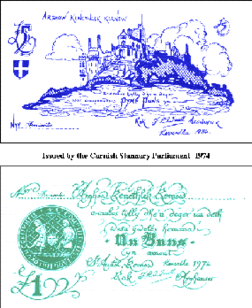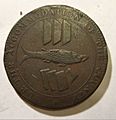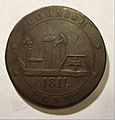Cornish currency facts for kids
Quick facts for kids Cornish currency |
|||
|---|---|---|---|
|
|||
| User(s) | Cornwall see also Constitutional Status of Cornwall | ||
| Subunit | |||
| 1⁄100 | dynar | ||
| Symbol | d, £, /~ | ||
| Banknotes | 500d, £1, 5/~, 10/~, 50p | ||
Currency is the money used in a place, like coins and banknotes. In Cornwall, people have used their own special money for a very long time. Coins were made there as far back as the 900s. Later, paper money (banknotes) was also printed in Cornwall until the 1800s.
Contents
Cornish Mints: Where Coins Were Made
A mint is a place where coins are made. The first known mint in Cornwall was in Launceston. It started making coins around 976 AD, a very long time ago! Only one coin from this early time is known to exist today. Later, after the Norman Conquest, the mint in Launceston was reopened.
An old Cornish play from the 1200s mentions a Cornish coin called the 'dynar'. It seems the 'dynar' was similar to the English silver penny used back then.
During the English Civil War (1642-1651), a mint was set up in Truro. It made coins for the Royalist side. This mint was later moved to Exeter.
Cornish Banks and Banknotes
Many towns in Cornwall, especially those with mining, started their own banks. These banks even printed their own paper money, called banknotes.
For example, 'The Mounts Bay Commercial Bank' was started in 1807 by the Bolitho family in Penzance. Another bank, the Consolidated Bank of Cornwall, was later taken over by Barclays Bank in 1905.
Some old Cornish banknotes are very rare today. In 2004, a banknote from the Falmouth bank sold for £540. You can see other examples of Cornish banknotes at the County Museum in Truro.
Stannary Money: A Modern Cornish Currency
In more recent times, a special Cornish currency was created by the Revived Cornish Stannary Parliament in 1974. It was called the 'Cornish National Fund'. This fund aimed to help Cornwall gain more self-governance. It also wanted to make people in Cornwall more aware of the Stannary Parliament's goals.
The 1974 banknotes came in different values: 5 shillings, 10 shillings, 1 pound, and 5 pounds. On the 5 shilling note, there was Cornish language text that meant: 'The National Fund of Cornwall promises to pay the bearer one day after sight the amount of five shillings.'
In 1985, the Cornish Stannary Parliament issued new notes for 50 pence and 1 pound. These were sold as a pair to help raise money. In 2000, new banknotes were issued to celebrate 200 years since Richard Trevithick's steam car climbed Camborne Hill. These notes were for 500 Dynars. They showed Saint Piran, who is the patron saint of Cornwall.
Cornish Tokens: Local Money for Trade
Cornish tokens, sometimes called Cornish Pennies, were like special coins. They were used a lot in the 1700s and 1800s in Cornwall for trade.
- One token from 1811 had the words "For the accommodation of the county." It showed a pilchard fish between blocks of copper and tin. On the other side, it said "Cornish penny" and showed a mine pumping engine.
- Another token from 1791, a halfpenny, had "Cornish Copper Half an Ounce" written around a shield. It also showed a druid's head.
- John Williams of Scorrier House also issued Cornish pennies. One from 1812 showed the Prince of Wales's badge (three feathers). The other side showed a mine engine and said "Payable at Scorrier House / One pound for 240 tokens."
Images for kids
See also
- William John Hocking of the Royal Mint




